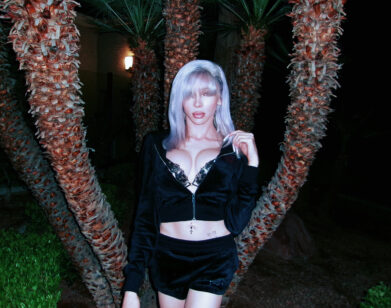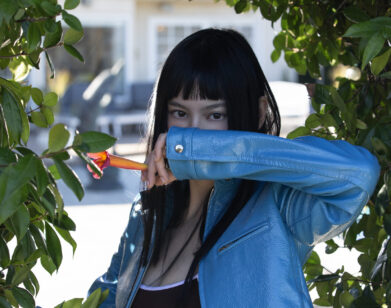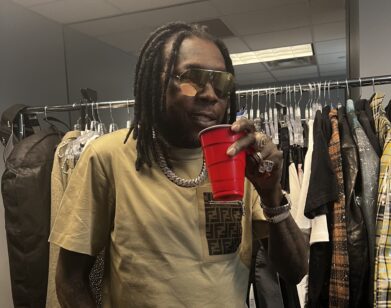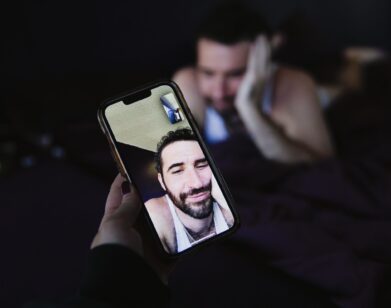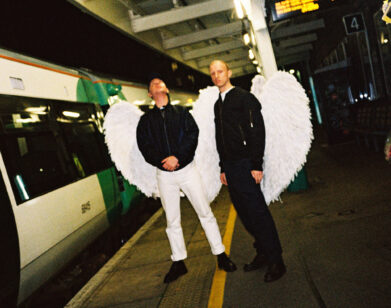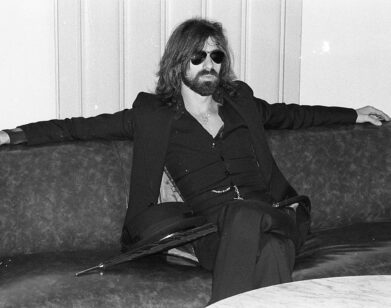Exclusive Remix Premiere and Interview: ‘Sonsick,’ San Fermin (Violetness Remix)
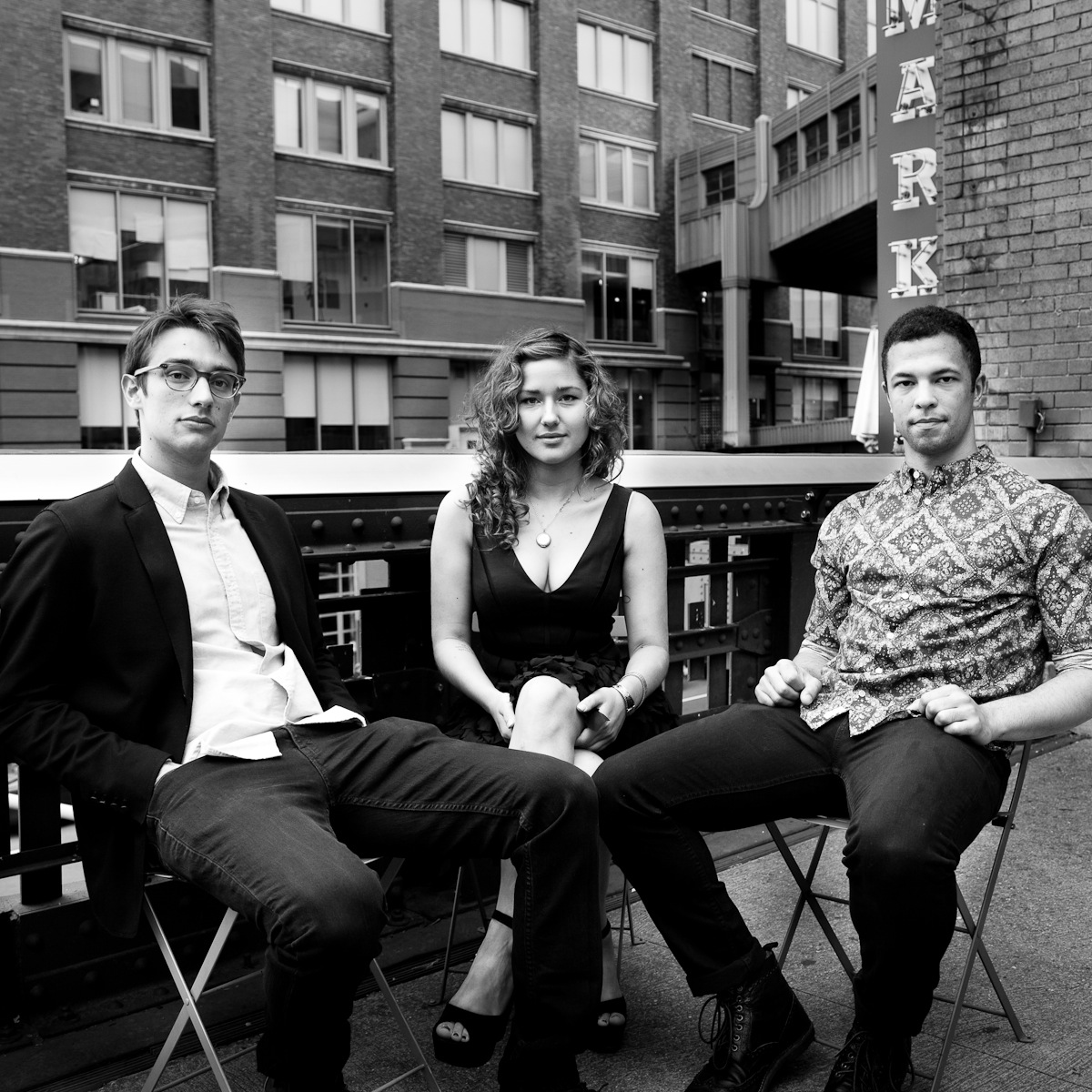
ABOVE, FROM LEFT: SAN FERMIN’S ELLIS LUDWIG-LEONE, RAE CASSIDY, AND ALLEN TATE. PHOTO BY THEA GOLDBERG
The origin story of San Fermin’s self-titled debut album, due out in September on Downtown Records, might be the most distinctive of any indie-rock record in recent memory—and one of the most impressive. After graduating from Yale with a degree in classical music two years ago, composer and songwriter Ellis Ludwig-Leone spent two months camped out at the Banff Centre, a secluded composers’ retreat in the Canadian mountains. His goal was to write a complex, fully orchestrated chamber-pop album centering on the big questions of growing up with which he’d recently found himself consumed.
By the time he left Banff for Brooklyn, Ludwig-Leone had written that album—and didn’t know who would play on it. He wasn’t planning on singing the male vocal part himself and had his friend Allen Tate in mind for the job (and with good reason; Tate’s deep, rich baritone bears an uncanny similarity to Bill Callahan’s); everything else, including the strong, sweet female vocals that were supplied on the record by Jess Wolfe and Holly Laessig of the band Lucius (and on tour by Rae Cassidy), would come later.
If you know all this before you listen to the album, its tight construction and the ease with which all the parts fit together might come as a surprise—which is a credit to Ludwig-Leone, who has cited the operatic nature of this particular writing process. It’s operatic in scale, too: horns and violins swell against Laessig and Wolfe’s keening appeals, while Tate sings his grand proclamations—”I haven’t got a religion, but I’m young, young, young,” he observes.
San Fermin was kind enough to share the Violetness remix of the album’s first single, “Sonsick” (hear the original here, for reference), which we’re pleased to debut below. Read on for our interview with Ludwig-Leone, in which he relates the greatest advice Scott Rudin ever sort of gave him.

ALEXANDRIA SYMONDS: It’s my job to listen to albums, so I have a lot to listen to, but I can’t turn yours off.
ELLIS LUDWIG-LEONE: Oh, my God. [laughs] Were you at the Glasslands concert?
SYMONDS: I was. I was standing right back near the bar. It was amazing.
LUDWIG-LEONE: Oh, good. That place has such weird sound, you can never tell what you’re going to get. I’m glad you liked it. There was certainly a good energy to that crowd.
SYMONDS: When you play live, do you find that people think that Allen wrote the music?
LUDWIG-LEONE: [laughs] No. We haven’t run into that yet. I think me talking on the mic helps a little bit, and we’re playing to audiences that seem to be familiar with us and the story of us. I’m okay with a little bit of confusion, though. I’m not in it for the glory.
SYMONDS: When you wrote this album, you didn’t know who was going to be playing the music. Did you feel like you were writing a house for other people to live in, or a framework for other people to inhabit?
LUDWIG-LEONE: I think that’s a nice way to think about it. For the male and female vocals, I think I was writing characters for them to slip into. Have you ever played those video games where you create a player? Before you play the game, you choose what it’s going to look like and the height and the hair color, and then you do Mario Kart racing or something. So it was a little bit of that, where I knew that this male character would only be able to say certain things, and I knew that the female character would only be able to say certain things. Who she was as a person wouldn’t allow for breaking those sorts of barriers. It was a general sketch of those people and their motivations. Once you fit it onto the singers, it’s sort of like an outfit—you have tailor it to how they look. For someone like Allen, I knew generally what would fit him, I suppose. For the female vocals, I had less of an idea, so I think I rendered those a little more loosely with the idea that it could fit maybe a little more generally.
SYMONDS: What about the instrumentals?
LUDWIG-LEONE: That’s sort of like the landscape. The interludes really feel like they are landscapes, to me. All the titles of them are like, “At Sea,” “At Night, True Love,” there’s one that’s called “In The Morning.” They’re setting the scene. It’s like starting a chapter of a novel—there’s maybe a few paragraphs talking about where you are before you meet these people.
I really wanted to create an appropriately lush world around what these people were saying. I tried to fill in, a little bit, the holes of what they’re capable of actually speaking about. Allen’s character has trouble articulating what he wants, except for that he wants it. [laughs] But maybe if you have some strings pushing with a certain kind of dissonance up high, or whatever, that’s sort of implying something. Or if you have a big low brass rumble, that implies something else. I thought of it as filling in the gaps, or a counterpoint to what they’re talking about.
SYMONDS: How close does the finished album sound to what you heard in your head?
LUDWIG-LEONE: It was a whole process. It took a long time to layer it all in. I actually listened to all the mini mock-ups I did right when I was starting the record, and it’s kind surprising how similar they are. The world came pretty well furnished as I wrote it. The things that changed the most were that when you add the vocals, there’s a certain intimacy that happens. Once the vocals come in, you realize that you don’t need some of that instrumental stuff. You strip out a little of it.
SYMONDS: How much of what ended up going on the album had you figured out in embryonic form before you started writing it, and how much came out during the six-week writing process?
LUDWIG-LEONE: I actually have this notebook that I hung onto after I wrote it. I had been thinking about it a little bit before I left, and then on the plane, I figured it out. There are three iterations of a sketch for it in this notebook. The first one is just asking questions, like, “What is this female character looking for?” And then the next iteration answered that, and then the final sketch was like, “Okay, here’s how this album is going to be set up. We’re going to have a male-driven song and a female-driven song, and they’ll have a counterpoint to each other. And then we’ll have an interlude.” By the time I got there, I had the armature for the thing pretty thought through. It certainly went through a lot of changes as I wrote, but I had 11 or 12 tracks and knew loosely what they would be about and who would sing them, just written on a piece of paper by the time I landed. It changes as you write. The first thing I wrote was this big instrumental epic conclusion, which actually never made it onto the record at all, but it had a bunch of harmonic and melodic stuff in it that ended up turning into a lot of the other songs. I guess the answer is that I had a sketch for the structure but not much in the sense of musical decisions having been made.
SYMONDS: Were you alone most of the time at Banff, or were you constantly interacting with other musicians?
LUDWIG-LEONE: [laughs] I was so lonely. I was really lonely. I got there, and there are other classical musicians who are there —there are a lot of performers who were in studios near me. I became good friends with a few of them, but it was a lot of time in a cabin by myself. What’s funny about that kind of situation is when you’re away from the benchmarks of your daily life, the things that you’re constantly interacting with, there’s this weird thing where your emotions fill up all the empty space. If you feel lonely, you feel really lonely. If you’re feeling excited about what you’ve just accomplished, you feel way too excited. Everything is amped up. I think that’s just because there’s no tempering factors.
SYMONDS: Yeah, routine is a mood stabilizer.
LUDWIG-LEONE: Yeah. There’s no helping your friend move into his apartment halfway through it. I think it’s a good thing for writing, but I wouldn’t put myself in that situation for other reasons, because it’s kind of exhausting.
SYMONDS: One of the things I love about the album is the way that the grand, epic, ambitious scale and attention to detail play against each other. Lyrically, you tackle these big themes through specific, detailed observations; and sonically, there’s this huge emphasis on dynamics.
LUDWIG-LEONE: I think what makes the record work—at least I hope it works—is the invention of the female character, who grew in scale as I wrote. With the male vocal, had grandiose intentions for that character. I wanted him to bring up big issues; even if he couldn’t quite say it, I wanted him to be pointing out that he’s looking for something important in his life at this time. That’s great, and I’m glad he starts to look for that, because that’s what I was thinking about, but I had this real kickback from trying that, because every time I pushed for that, it just felt too grand, too much, like, “Recent Yale graduate concept album about life,” like, give me a break, this is just the worst.
Having that female character was so important for me, because while I feel a lot of those issues that the male character is exploring, and they’re things that I’m really interested in, there’s also this voice that just like, “All right, man, let’s just slow down a little bit here. Everything’s fine.” Or, “Everything’s fucked.” But let’s not be so self important about this. I think that what the female vocal really does in this record, is she’s a little less convinced that anything can be accomplished with this grandiose thought. She also requires a little more to be convinced that she should be engaging any of this stuff. She’s refusing these slightly dopey romantic advances that this guy is making. She was really helpful for me, because I feel both of those things. Both of those things are equally valid viewpoints; and I think it’s in the conflict of those two that you actually get to something interesting— that those two things can exist at the same time.
SYMONDS: There’s so much about sleeping and sleeplessness and dreaming on this album. Are you the kind of person who can fall asleep immediately, or do you tend to toss and turn?
LUDWIG-LEONE: I’ve always had trouble falling asleep.
SYMONDS: I’m not surprised.
LUDWIG-LEONE: Those interludes feel like dream sequences, anyway. There is a version of [interpreting] this album where it could all be happening in one couple’s head as they just lay in bed next to each other. I’m not sure if that’s the way to listen to it, but it is about these lapses in consciousness. Long story short, I have a lot of trouble sleeping.
SYMONDS: Do you remember your dreams?
LUDWIG-LEONE: [laughs] When I was at Banff, I had just been working as an assistant on this film, which was produced by this guy named Scott Rudin, who’s a legend. I don’t know him at all, but the first night I got there, before I had written anything, I fell asleep, and I had this dream that he gave me this sage piece of advice about this record. So I woke up in the middle of the night and I found my laptop and I typed out this advice and closed it. When I woke up the next morning I was like, “Oh my God, right, I figured out the record.” And I looked at what I had written and I just wrote, “Should be sort of creeeeeeeepy,” with like, eight E’s. So that was the extent of remembering my dreams. “Sort of creepy,” that was the goal, I guess.
SYMONDS: [laughs] Maybe this is something you can only address in retrospect, and trying to ask you this question now, when you’re in the middle of it, is futile or something—but how much do you think of this as a mid-20s album? I honestly think that “Bar” is on par with “Apartment Story” and “All My Friends” in the pantheon of songs about living in your mid-20s in New York City.
LUDWIG-LEONE: It gives me shivers to hear you say that, thank you. That’s truly a compliment. I think it’s entirely about that. In fact, I think that was the very first goal of this record. It probably stemmed from the observation of, like, “I’m feeling some things. How can I deal with these things in a way that feels honest to this moment in time?” It was very much about the moment that it was being written in. I wrote it a year and a half ago, and already I feel different things. It was really about trying to capture this moment of just being out of school, being on your own—and being very on your own for a second, in this place where there’s literally no one else around and feeling very isolated. So a “mid-20s album?” Absolutely. Ideally, it also resonates across the age groups, too. A lot of the songs deal with issues of mortality and falling in love or not falling in love, those sorts of things that obviously everyone can relate to. There are definitely moments where I’m like, “I’m young, I don’t really have religion, I don’t really have exactly an idea of where I’m going to find something in my life that makes me feel like I’m doing something right. So let’s just look around.”
SAN FERMIN IS OUT ON DOWNTOWN RECORDS SEPTEMBER 17. THE BAND WILL PLAY AT (LE) POISSON ROUGE IN NEW YORK SEPTEMBER 20. FOR MORE, VISIT ITS WEBSITE.

